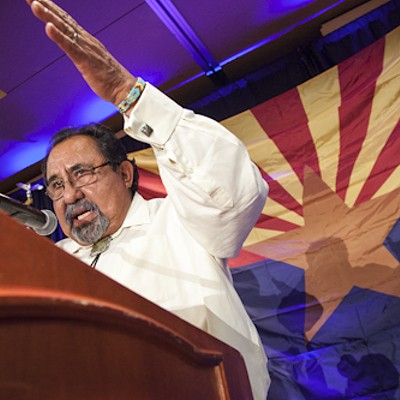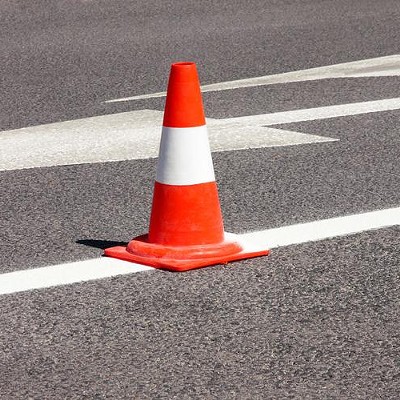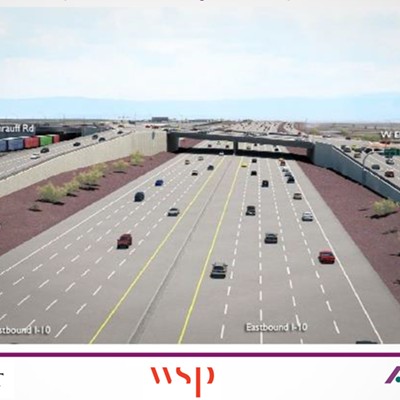If you look at a map of Tucson, chances are there's a blank space right under Morris K. Udall Regional Park on the eastside of town. This large area stretches from the southern boundary of Udall down to Speedway Boulevard, from Pantano Wash on the west to Van Horne Elementary School on the east.
Almost 100 acres, this land is a hidden mystery to most Tucsonans.
All of that is about to change in the spring of 2011, when work begins to extend Sabino Canyon Road south to connect with Kolb Road, just north of the Lowe's shopping center. (Incidentally, Kolb and Sabino Canyon will intersect twice, with about three miles between the two intersections.) An expensive bridge will be built across the Pantano Wash, and the work promises to disrupt a very peaceful neighborhood for years to come.
Anyone who regularly drives south on Sabino Canyon knows that traffic comes to an abrupt halt when it reaches Tanque Verde Road. Drivers now have to turn right or left, because straight ahead is a cul-de-sac. At the same time, vehicles back up on Tanque Verde waiting to make a left-hand turn onto Sabino Canyon. It's like a game of Sim City gone terribly awry.
So planners included the extension of Sabino Canyon Road in the $2.1 billion Regional Transportation Authority that voters approved in May 2006. The federal government is kicking in $11.9 million of the estimated $21.9 million for the project, so it's fully funded. Although many details are yet to be decided, the four-lane highway and the bridge will span a forgotten part of Tucson.
For the first time, passing motorists will cruise through the nefarious Vincent Mullins Landfill, and get a clear view of the green-minded Speedway Recycling and Landfill Facility. They'll get to see spikes of blue flame piercing the night, burning off excess methane from grassy meadows covering buried trash.
Over the years, the two landfills have merged into one vague landfill in most people's minds, but they couldn't be more different. Mullins Landfill is closed, while Speedway Recycling is a thriving business which operates under the radar of most Tucsonans. Are these neighborhood dumps ready for their close-up?
City planners held the first public meeting on the Sabino Canyon extension on Sept. 10 at Udall Park, and a standing-room-only crowd showed up.
The city has known that Sabino Canyon Road was a problem long before 2006. The extension was approved in the 1986 Pima County bond election, but was scrapped when the funds ran out. In 1989, all the rights of way were secured, but the funds were not.
Now, planners feel a sense of urgency.
"The reach of Tanque Verde between the Kolb-Tanque Verde intersection and Sabino Canyon is the highest traffic volume on a segment of roadway within the city limits," said Jim Glock, the city's director of transportation. "This project gives us another bridge across the Pantano Wash. We are seeing an erosion of public safety, in response times, to this quadrant of the community. This bridge is going to allow us to bring those response times back into the desired timeframes."
Planners admit that they don't know exactly how they're going to build across the Vincent Mullins Landfill. Thankfully, they only have to navigate the northwest corner of the dump's 30 acres. The city landfill operated for 11 years, from 1976 to 1987—and managed to become a major embarrassment: Mullins Landfill was unlined and soon polluted the groundwater. Cleanup and capping ended just two years ago.
No one considers the landfill to be toxic these days, and it looks like a bucolic meadow, surrounded by scattered vents and methane burners. A dozen years ago, plans were afoot to turn this peaceful acreage into a park with youth-sports fields, but the environmental studies did not bode well.
In a city newsletter, Cristina Polsgrove, public information officer for environmental services, had this to say about Vincent Mullins: "This closed landfill was capped, and storm-water and methane-control systems were installed. ES will monitor the site for the next 30 years to ensure there are no impacts to the groundwater. In July 2008, ES performed a feasibility study to determine if city landfills, including Mullins, are potential gas-to-energy sites. Due to the size of Mullins Landfill, the methane produced is sufficient enough to support a gas-to-energy system."
So maybe there is a greener day in the landfill's future, when its flammable gases will heat the pool at Udall Park. A new road and increased attention could bring that day closer.
The speakers at the Sept. 10 meeting did furnish some specifics. The intersection at Kolb and Sabino Canyon will sport a signal light, and the project will feature bike lanes, sidewalks, landscaping, artwork and flashing crosswalks leading to Udall Park. Speaker after speaker stressed how open they were to suggestions and local involvement.
Placating the residents who live around Udall Park is a good idea, because they've gone to the mats before in battles with the two landfills. They lobbied to get Mullins Landfill closed 25 years ago. A dozen years ago, they persuaded Speedway Recycling to erect berms and water their fields frequently to cut down on dust.
If Vincent Mullins is your father's dump, Speedway Recycling and Landfill is the dump of the future. They accept mostly construction debris and green waste, and they aim to recycle most of it into products such as mulch, compost, pipe bedding and decorative rock. Owned by the Fairfax Companies, Speedway is a private landfill with 54 acres, which opened to the public in 1990.
CEO Jason Ashley Tankersley was at the Sept. 10 meeting and plans to serve on the citizens' oversight committee. The project will run right by the Fairfax Companies' headquarters at 1360 N. Kolb Road. "I'm not too crazy about having the traffic backed up in front of my office," said Tankersley, "but I think it should alleviate a lot of problems."
He welcomes the roadway skirting his property to the north. "We're adding several different businesses onto the landfill. On those berms we built on the northeast side along the park and the school, we're going to put a nursery. ... We're trying to create a very sustainable business model, where everything gets processed and reused."
Future maps of Sabino Canyon Road will look a lot different, and the mapmakers might as well draw in the landfills—because everyone will see them soon.












